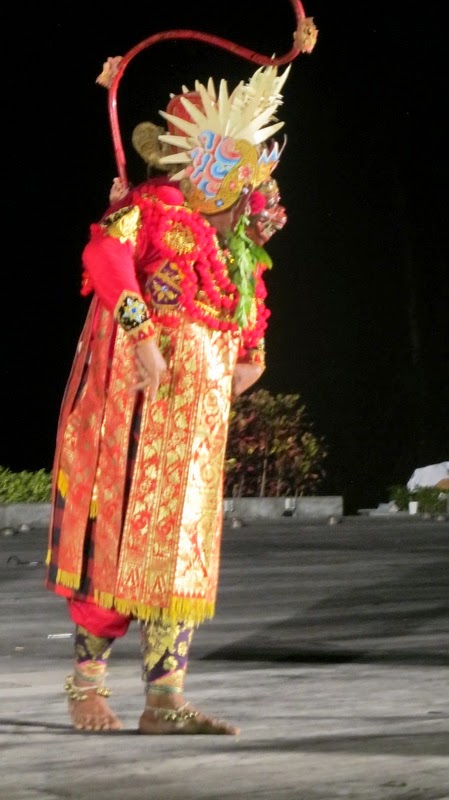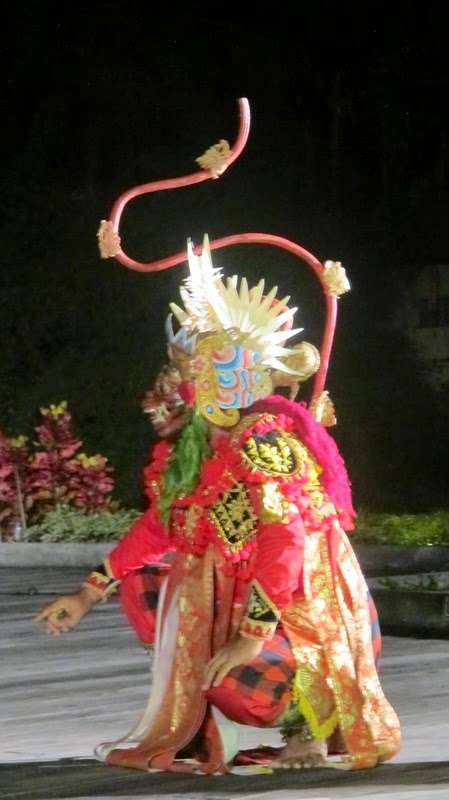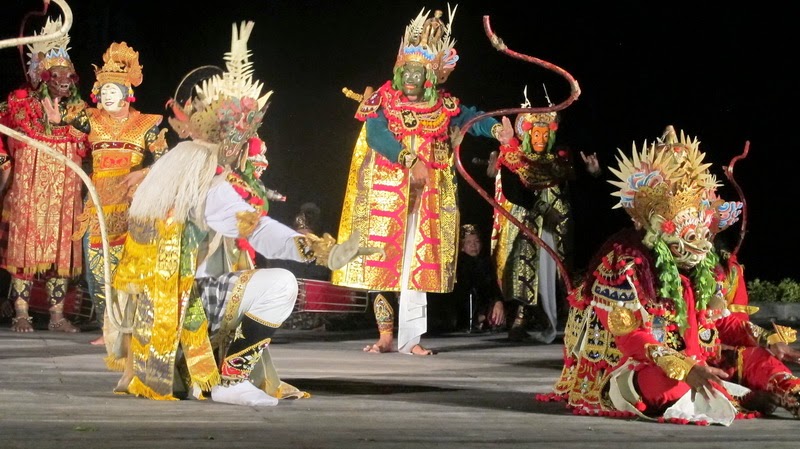For the Balinese, going to temple is like going to a garden party: one gets all dressed up and gorgeous and goes to a village reunion in an exquisite setting. There is live music, milling masses, eye candy in the way of colourful offerings lining carved and painted pavilions, and often delicious food at carpark stalls. Everyone prays to the temple gods, of course, but the seeing and being seen is a big part of the visit. For the teenagers, late at night, the heavy petting in a temple setting is sometimes a draw card.
For many Balinese, home is no longer the leafy garden setting it once was: in most areas the village’s communal living room has become a busy road — so temple visits are treasured.
Invitations to palaces, with their spacious courtyards and ornate pavilions, are much sought after and considered highlights of ceremonial calendars.
Not surprisingly, temple and wedding fashion is the most dynamic fashion growth sector on the island, outdoing even yogini, surfy and disco dress trends combined.
Over the past 12 months, for example, we have seen the kebaya (chemise) sleeves racing up towards the armpit and sarong (kamben) and batik hems heading north at the same rate. Trends in kebaya fashion are alarming: the ratio of transparent patches to lacey solids on the kebaya is tipping so much towards the see-through that very soon Balinese women will be topless again!
 |
The head of Puri Satria Dalem Kaleran Kuta
in his family house temple on
the last night of the Barong Mapajar
ceremonies, 31 August 2014
|
In men’s temple fashion we have seen the chequered, yellow and opalescent skirt cloths (saput) disappear in favour of all white; worn over bold-patterned Central Javanese batiks.
For the truly fashionable ladies the batik has been replaced with zig-zag weave ikats and pelangi (tie-dye) cloth from Nusa Penida.
Gold brooches are now like breast plates: the brooches are wearing the lady, not the other way round.
For the temple toddlers and juniors the fashion trends are even sharper: turbans have to be full-bodied and effusive and temple sashes worn around the hips not the waist for that serious roué Veda-rat look.
Sadly many temples have succumbed to the trend for heavy black andesite stone facelifts and paved courts — but in some temples the traditional swept dirt or grass courtyards survive.
3 September 2014: To Pura Dalem Kahyangan Sidakarya at noon for the consecration of some new pavilions
My old buddy, Putu Suarsa, has had a huge success over the years keeping the garden courts of this impressive temple fully natural and classical.
Today, it is a joy to enter the grassy courts and admire the red-brick Majapahit architecture and accompanying decorations. The new trendoid satin pleated trim has been kept to a minimum. Village elders and the youth group are milling. The lady priests are dressed to the nines, in white on white, with giant, paste brooches glistening.
At the back of the temple I discover a brand new Pura Taman (water temple) — a Majapahit tradition enjoying a renaissance in Bali, as budget boutique hotels blossom in between — and a cock-fighting hall in full swing. Here everyone is in black on black with heavy chains. Some are wearing black balaclava as well (cock fighting is illegal). Cheeky boys tell me that they are ISIS.
Back in the temple the boy band gamelan is thrashing away, the high priest is ringing his bell and the village brahmans are planting the pedagingan (revitalizing elements) in the shrine bases to ensure the temple’s health for another generation.
It is a heavenly atmosphere. The fact that the Balinese culture survives intact in the cess-pit of tourist commercialism is one of the civilized world’s great miracles.
31 August 2014: Puri Satria Dalem Kaleran, Kuta Palace for the last Barong dance of the season (the Puri’s three month long once every twenty year Barong refurbishment season)
I arrive at 3 p.m. to find the palace’s handsome grass forecourt already set up for tonight’s performance.
Inside, in the large family house temple the dancers are getting into their costumes as the house priest leads a prayer session nearby.
I have gotten to know many of the principal dancers, trancees, priests and princes over the three months spent following the rituals — from the removal of the mask ceremonies (see video Mamunggal Pelawatan: http://youtu.be/QG-SmuE5tZI), the empowering of the newly restored masks (and subsequent break-out of trancees from the Pura Dalem Tunon graveyard into the wedding reception garden party in a neighbouring hotel). I continued filming, a few weeks later, through the amazing calonarang performance (see video Calonarang: http://youtu.be/EkVripK_9Rg) when the main Kuta drag was closed and all the island’s demons were invited down, and a posse of entranced rangda (witch) dancers invaded Sky Garden at peak hour,……… and now the finale.
I have gotten to know a lot of the principals on Facebook: the refined princes, the cheeky trance-masters and the core group of photographers lead by Linggar Saputra Wayan (see his fb page where hundreds of brilliant photos are published).
Even though my allegiance is to a rival palace I have been welcomed into the fold and even given the house waist-cloth which I now wear, proudly, to any Kuta event.
I have become a Kuta Palace groupie and a huge fan of Kuta’s Anti-Reclamation movement, the island’s most active (as we go to press the new president is reconsidering the controversial approval to fill in gorgeous Benoa Bay).
* * *
Tonight, as the last trancee hurls himself on his keris in front of a shivering barong, the lights are dimmed and there is a sense of achievement and relief. Relief that, for this palace at least, the heavy round of restoration rituals are over for another 20 years.
See my video of tonight’s terrific traditional Barong Mapajar (http://youtu.be/hTp9VkhOLKI).
9 September, 2014: To the Rumah Topeng and Wayang at Kemenuh for a performance by the fabled Tejakula Wayang Wong troupe from Northeast Bali.
In 2012 Javanese collector Hadi Sunyoto created a beautiful museum of Javanese joglo buildings in a parkland setting — complete with open stage, restaurant and seminar rooms. The collections of masks, puppets, barong and statues are from all over Indonesia.
Tonight I join the Ubud expat seniors and a battalion of momentologists (local photographers) to enjoy the quirkish dancing of this unique troupe (see my video: http://youtu.be/L_c8PX19ZSE).
 |
Brahman cousins at the Griya Dalem Sibang wedding
|
 |
Cheeky Dewa Alit at the Barong Mapajar ceremony, Puri Satria Dalem Kaleran, Kuta
|
=======================================================================
MELASPAS CEREMONY AT PURA KAHYANGAN
SIDAKARYA, 3 SEPTEMBER 2014
========================================================================
Barong Singa Mepajar, Puri Satriya Dalem Kaleran, Kuta, 31 August, 2014

























































































